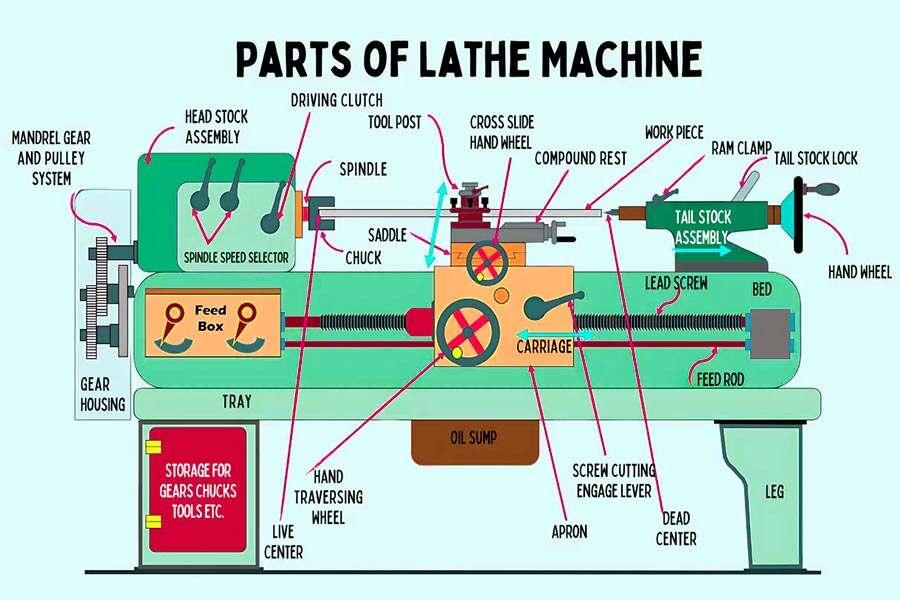Welcome to the captivating realm ofwood turning! In front of a woodturning lathefor the very first time, the ocean ofhandles, wheels, knobs, and metal partscan be daunting. It is like standing in front of a complex mechanical orchestra, each part with its own duty to fulfill.
But don't worry! This "fear" is the beginning of discovery Learning the names of these pieces and their functions is a valuable first step in loosening your imagination and bringing a plain piece of wood into a beautiful piece of art They work together tohold, turn, cut, and fit to complete the magical process.
To have you turning round in no time and not burdened by the complicated design,we present to you the five most basic "backbone members" of the woodturning lathe. Mastering these, you have learned the basic code to operate the lathe.
Quick reference Table Of Core Components Of Wood Lathes
| Component name | Core function | Key subcomponents | Core role |
|---|---|---|---|
| Headstock | Drives the workpiece to rotate | Spindle, drive system (pulley/gear), chuck/panel | Provide power source, fix and rotate the workpiece |
| Tailstock | Supports the other end of the workpiece | Top sleeve, handwheel, live ejector | Balance the force on long workpieces and prevent machining vibration |
| Carriage | Guides the cutting tool | Banjo, tool rest, locking handle | Provide a stable support platform for the turning tool and control the cutting trajectory |
| Bed | The foundation for carrying all components | Ways | Ensure the precise movement of the tailstock/tool rest and maintain the rigidity and accuracy of the entire machine |
We will use a wood lathe parts diagram simply to learn in detail the name and function of each of the major parts, how they are related to one another, and demonstrate the application of these parts with an example. Finally, we will also see how these age-old designs get pushed to unprecedented levels in freshCNC turning.
Here's What You'll Learn:
- Detailed description of the names, designation, functions and collaborative working methods of the five primary units of woodworking lathes (e.g., spindle box, tailstock, etc.). Reference should be taken from the diagrams to further understand.
- Unveiling the power nature:unearthing spindle box and spindle, contrasting belt drive with DC speed change variation, and summarizing the impact of spindle thread specification and Morse taper on chuck and accessory selection.
- Describe bed, tailstock and support structure operation:describing the basis of stability, emphasizing the importance of accuracy of bed guide rail, and declaring completed the slide box idea in the woodworking lathe tool holder base.
- Key accessories guide:referencing key accessories, ranging from workpiece clamping helpers to safety helpers.
- Explaining the four wood lathe main constraints:emphasizing the four main woodworking lathe constraints to allow design not mislead.
- Breakthrough case sharing:in the aerospace turbine blade example case, illustrating how5-axis CNC turningoutper forms the woodworking lathe constraints to support ultra-high accuracy and intricate geometric shapes.
- Upgrade decision guide:Provides four key indicators to help you determine when the time is right to transition from hand turning toCNC machining, and provides exact guidance on precision, design complexity, material needs and production volume.
Let's get started today, revealwood lathe partssecrets, and watch technology drive the limits of manual production away!
The "Big 5": Major Components Up Close and Personal
The most fundamental data on awood latheis to get aquainted with the function of its primary parts. These five - headstock, tailstock, bed, tool rest and spindle - all work together to decide the lathe's performance, accuracy and working experience. Regarding reading, it is advisable to refer to a standard "wood lathe parts diagram" for correlation with the respective position, which will immensely help in your comprehension.
Summary of the comparison of core component functionality
| Component name | Core function | Key features |
|---|---|---|
| Headstock | Power source & rotary drive | Provide power, control speed, support spindle, determine maximum rotation diameter |
| Bed | The solid foundation that connects the headstock and tailstock, the “backbone” of all the components. | The “chassis and skeleton” of the entire machine. |
| Tailstock | Supports the long workpiece at the other end, providing stability and security. | A “steady hand” holding a ladder. |
| Spindle | The shaft that extends from the headstock and rotates, with a chuck at the front end to directly clamp the workpiece. | The “drive shaft” of the car engine connected to the wheels. |
| Tool Rest | Provides a solid support point and leverage point for the turning tool. | The “handrail” that the engraver uses to stabilize the carving tool. |
1. Headstock
Power core, transmitting rotating power and controlling speed.
Controls largest diameter of lathe rotation (critical size limitation).
2. Bed
Half-integrated stiff base and accurate guide rails.
The cast iron material (mainstream) is superior in cutting vibrations and smooth processing.
3. Tailstock
Portable supporting auxiliary for bearing long workpieces.
The live center (mainstream) rotates with the workpiece, significantly reducing friction and scorching of workpieces.
4. Spindle
Directly rotating motor shaft in the spindle box.
Supports the chuck/center, power torque delivered through it, its typical interface (taper/thread) determines the interchangeability of accessories.
5. Tool Rest:
The platform of work and support for tools.
Adjustable height/position and inclination, and it is a critical part of the cutting process, precision, and safety.
The live top spindle box initiates rotation of the size, thecast ironbed reduces vibration, the tailstock cuts down on friction, the tool holder regulates cutting, and the spindle drive provides the torque - all five units together provide the foundation of the lathe.
The Powerhouse: The Headstock and Spindle
The spindle box is the primary power source of the lathe, not just the place where power transmission is initiated but also the largest supporting component that leads to the rotation of the workpiece. The spindle box contains the spindle and driving mechanism, and has a direct impact on the processing capacity and accuracy of the lathe. It is necessary to be familiar with the main characteristics of the spindle box and spindle in order to work, select, and maintain the lathe. The following table presents data on the main operating parts of the spindle box and spindle:
| Feature | Function/Description |
|---|---|
| Power source | The "power heart" of the lathe. Transmit the motor power to the spindle to drive the workpiece to rotate. It is the energy starting point of the entire processing process. |
| Drive mode | Belt drive: simple structure, easy maintenance, but manual shifting is required for speed regulation.DC variable speed (EVS): electronic stepless speed regulation, easy operation and fast response. |
| Spindle thread | Standardized external thread at the front end of the spindle (such as metric and imperial).Core function: used to install and tighten workpiece clamping devices such as chucks and panels. Specifications must match! |
| Spindle Morse Taper | A standard tapered hole (Morse Taper, MT) in the spindle bore (sometimes the same as the tailstock bore).Core Function: Provides precise, self-locking positioning for mounting accessories such as centers, drill chucks, boring bars, etc. The taper number (such as MT3, MT4, MT5) must match the accessories. |
1.Power source
The spindle box is the powerheartof the lathe, withan integralgear set/speedcontrolmechanism, which drives the spindlethrough high-precision bearings. Itsaccuracyandstiffnessdirectlyinfluencetheprocessing quality (roundness, finish)of the workpieceandthecutting load capacity.
2.Drive mode comparison
| Mode | Features | Applicable scenarios |
|---|---|---|
| Belt drive | Simple structure, easy maintenance, low cost; manual gear shifting and speed regulation (stepped speed change) | Limited budget, infrequent speed change operations |
| DC speed change (EVS) | Electronic stepless speed regulation, efficient operation; dependent on control system, high cost | Precision machining, frequent speed change scenarios |
3. Spindle thread
- Function:Mounting disk/chuck interface (e.g., three-jawed chuck).
- Key:Thread specifications must be exactly matched (e.g., metric M39×4, imperial 2-1/4"×8 TPI), otherwise cannot be mounted or can result in safety hazards.
4. Spindle Morse taper
- Function:Self-locking locating accessories (center, drill chuck, boring bar) by standardized tapered holes (e.g., MT3/MT4).
- Key:Taper number (MT#) is for matching the accessory and is released by a special wedge.
- Application:Center support workpiece,drilling(drill chuck), precision clamping (spring chuck).
The spindle box is the "power heart" and provides power with belt/EVS drive; the spindle clamps the chuck by standard threads and accessories by Morse taper precision - all three together are the foundation of the lathe's processing capability.
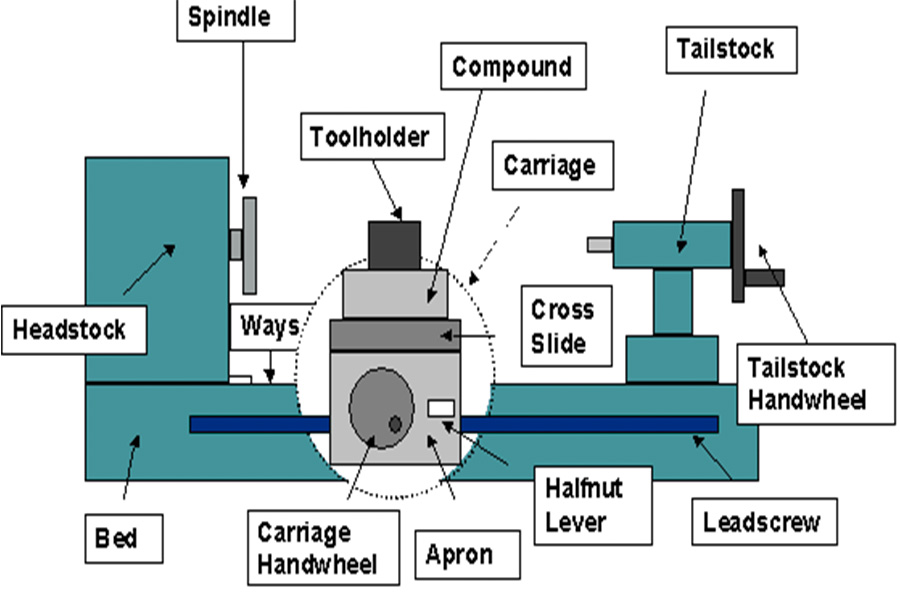
The Support System: Bed, Tailstock, and Carriage
| Supporting parts | Woodworking lathe characteristics | Metal lathe characteristics |
|---|---|---|
| Bed rails | Key foundation, high flatness and precision | Key foundation, extremely high flatness, precision and rigidity |
| Tailstock | Fixed to the bed rails through a locking mechanism | Fixed to the bed rails through a locking mechanism |
| Slide/tool holder | Simplified to a manually moved tool holder base | Complex structure (slide box), including handwheels, gears (such as apron) |
1. Bed rails:
Being the foundation of the entire lathe, its accuracy and flatness are the key. Anybendingor deviation of the rails will be transferred directly to the workpiece and cause machining defects (e.g., taper, vibration), hence it is the stability and accuracy guarantee foundation.
2. Tailstock locking
The tailstock needs to be firmly locked into the selected position of the bed rail to support the other end of the workpiece (usually with a top) or accommodate tools such as drills. Reliable lock systems (such as lever locks, bolt locks) ensure stability such that the tailstock will not move during processing and the workpiece will not vibrate or shift.
3. Slide/tool holder:
On a wood lathe, the tool holding portion carrying theturning toolis reduced to manually movable tool holder base, and the operator manually pushes it along the guide rail by hand or using an uncomplicated mechanism for the feed. This in ametal latheis done by a slide box, a more complex mechanical assembly, usually a handwheel and a gear train (often incorporated into an apron cover) for manual or automatic accuracy feeding motion.
The bed, the tightly clamped tailstock and the hand tool holder base (in woodturning lathes) together provide a firm support system for lathe use, and this is the basis of ensuring machining accuracy and safe usage.
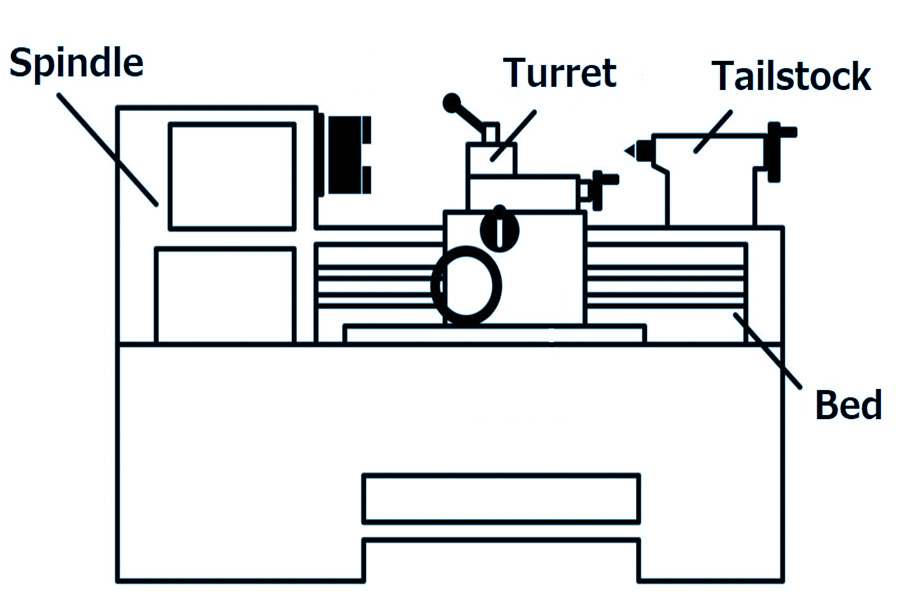
Beyond the Machine: Essential Lathe Accessories
| Accessory category | Accessory name | Main function | Key advantage | Main limitation | Typical application scenarios |
|---|---|---|---|---|---|
| Workpiece clamping | 4-Jaw Chuck | Clamp each point of the workpiece independently | Strong and stable clamping force, can clamp irregular/eccentric workpieces, flexible clamping range | Adjustment and alignment are slightly more complicated, usually more expensive than three-jaw chuck | Bowls, plates, non-cylindrical objects, and workpieces that require strong clamping |
| Faceplate | Fix the workpiece on the plate surface with screws | Clamp oversized, flat or irregular workpieces, simple and reliable structure | It takes a long time to install the workpiece, and it is necessary to drill holes in the workpiece | Large flat plates, wide bowls, and special-shaped parts that cannot be clamped by chucks | |
| Drive Center | Clamp the end face of the workpiece, and the tailstock supports the other end | Quickly clamp long cylindrical workpieces, low cost, suitable for axle parts | Clamp only one end of the workpiece (tailstock cooperation is required), and the clamping force is limited | Turning long straight workpieces such as chair legs, spindles, and pen holders | |
| Tailstock accessories | Live Center | Support the rotating end of the workpiece and rotate with it | Support the workpiece to reduce vibration, greatly reduce frictional heat, and improve machining accuracy and safety | Bearings need to be maintained regularly, and different models have different load-bearing/accuracy | Almost all turning operations that require tailstock support |
| Drill Chuck | Clamp the drill bit to drill holes on the lathe | Perform precise axial drilling on the lathe, eliminating the need to change machine tools | Need to adapt to the Morse taper of the tailstock, and the drilling depth is limited by the tailstock stroke | Drill holes on turned workpieces (such as pen holders, hollow vases) | |
| Safety equipment | Safety Goggles | Protect the eyes | Prevent flying debris and dust from entering the eyes, fit the face to protect against direct impact | Protection is limited to the eyes | All lathe operations |
| Face Shield | Protect the entire face | Comprehensively protect the face from impact from debris and wood blocks, usually worn outside the glasses | May not fit as well as goggles, and attention should be paid to anti-fogging | High-speed turning, rough turning, and operations with a large risk of debris |
1. Workpiece clamping is the secret:
The four-jaw chuck is the most universal and strongest clamping, especially well adapted to eccentric and irregular workpieces (such as plates and bowls), and one of the "must" tools for the experienced lathe user.
The panel is the best possible for clamping large, flat or oddly shaped workpieces. It is screwed on, simple and reliable.
The center tailstock heart-shaped chuck is a conventional choice for mass production turning long straight workpieces (chair legs, pen holders), which is convenient and economical.
2. Tailstock accessory precision and lifting capacity
Live center is the key to fixation of workpiece, minimizing vibration and friction heat. Use of a high-quality live center with ball or roller bearings is highly recommended, which will greatly enhance processing quality and safety.
Drill chuck converts the lathe into adrilling machine, achieving precise center drilling on the rotating workpiece, which greatly extends thelathe function(e.g., pen holder making and hollow vases).
3. Safety equipment cannot be compromised:
Goggles are the first line of defense against high-speed particles and dust in the air, and should always be worn.
The face mask adds extra protection for the entire face and is strongly advisable to be used in addition to goggles, especially when performing high-speed turns, roughing, or if there will be a high chance of chipping. Safety first, foremost.
Choosing the right lathe accessories properly - from hard workholding (four-jaw chuck/faceplate/heart chuck) to precise tailstock support (live center/drill chuck), and never neglecting to ensure safety protection (goggles/mask), is the primary foundation to surmount the limiting constraint of the machine itself and unleash the wood creativity in a safe and efficient way.
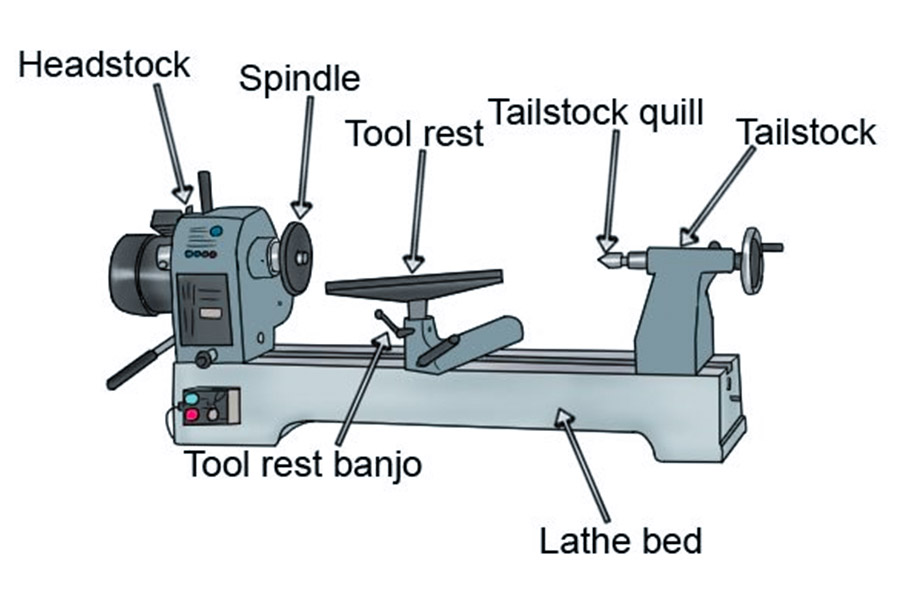
The Manual Limit: What a Wood Lathe Can't Do
Wood lathesare foundational machines for making beautiful turned wood pieces, but when moving from hobby to commercial production or precision application, it should be clearly realized what they can't do. What follows is a brief overview of their major limitations:
| Limitation category | Specific manifestation |
|---|---|
| Geometry limitation | Only strictly rotationally symmetrical bodies can be manufactured. It is impossible to process holes, planes or complex non-rotationally symmetrical surfaces on the side. |
| Precision and repeatability | Highly dependent on operator skills, it is difficult to ensure that the size and shape of multiple parts are exactly the same. |
| Material limitation | Mainly used for wood (and some soft materials), cannot effectively process metal or high-strength engineering plastics. |
| Low efficiency | Manual operation, long processing time for a single piece, completely unsuitable for mass production needs. |
1. Geometric limitations:In essence, it can only produce bodies of rotational symmetry (columns, cones, balls, bowls, etc.).Drilling holes, cutting planes, grooves or intricate reliefs on the side of rotating workpieces is impossible. It will require other machine tools or secondary complicated operations for asymmetric shapes.
2. Repeatability and precision:Precision (roundness, size, finish) is tool-dependent and dexterity of the hands. Hard to produce the exact same parts; not suitable for applications requiring strict interchangeability or high-precision matching.
3. Material limitations:Designed for wood. Turning metal (even soft metals) wastes material, wears tools, wears machinery and is hazardous; the same goes for high-strength engineering plastics, and may produce toxic fumes.
4. Inefficiency:The single-piece sequence of operation (clamping, rough and fineturning, sanding, unloading) entails full manual operation, which is highly inefficient and expensive and cannot satisfy batch demands.
Wood lathes are specifically well-suited to the production of turned wood components, but their geometric limitations, heavy dependence on human effort, material constraints, and built-in inefficiency necessarily set the limits of their capacity to evolve from hobbyist production to professional, precision, or quantity manufacturing.
The Ultimate Evolution: From Manual Turning to 5-Axis CNC
We are a specialist in the core business of precision machining and have witnessed the phenomenal shift from manual to digital smart manufacturing. The progress of technology, especially the invention offive-axis CNC machining, has completely transformed the boundaries of manufacturing intricate parts.
Comparative overview of technology evolution
| Features | Manual turning | CNC turning | Five-axis CNC machining |
|---|---|---|---|
| Control method | Manual operating handle, visual inspection | Computer program control | Computer program control |
| Number of operators | 1 person for full operation monitoring | 1 person (clamping, programming, monitoring) | 1 person (clamping, programming, monitoring) |
| Accuracy | Reliable on technician experience, relatively low | High precision, high repeatability | Ultra-high precision, ultra-high repeatability |
| Degree of freedom | Usually 2 axes (X, Z) | Usually 2 axes (X, Z) or 3 axes | 5-axis linkage (X, Y, Z, A, B/C) |
| Typical capabilities | Cylinders, end faces, cones, simple grooves | Complex contours, threads, precision holes | Extremely complex surfaces, multi-angle features, non-rotationally symmetrical parts |
| Efficiency/flexibility | Inefficient, slow changeover | High efficiency, medium flexibility | High efficiency, extremely high flexibility (multi-faceted machining in a single clamping) |
1. What isCNC turning?
Computer numerical control (CNC) turning utilizes pre-set program instructions to precisely control the tool movement and spindle speed of the machine tool. It replaces traditional manual operation and realizes automation, high repeatability and high precision far beyond the level of manual operation. Machining of complex contours, precision threads and holes is straightforward.
2. What is 5-axis machining?
"5-axis" refers to the ability of the machine tool to control five degrees of freedom of motion simultaneously. In addition to the usual turning axes (usually the X-axis - radial, Z-axis - axial) and the C-axis (spindle) for rotating the workpiece, the key is the inclusion of two rotary axes (A-axis and B-axis). This usually means that the tool head or worktable rotates and tilts in space.
3. Disruptive capabilities
The five-axis linkage technology is such that the machine tool can use the extra rotation axis (A/B axis) while the workpiece is continuously rotating (C axis) to allow the tool to access the workpiece from almost any direction in space. This creates revolutionary changes:
Breaking the constraints of rotational symmetry:Machining parts that are rotationally symmetrical around a single axis is no longer possible. Asymmetric grooves can be machined on the side of the cylinder, tapered holes can be drilled, and complex 3D surfaces can be machined.
Single clamping completes complex processes:It is possible to clamp the workpiece once to complete a variety of processes such as turning,milling, drilling, andengraving, which significantly improves accuracy (avoiding repeated clamping error) and efficiency.
Machining difficult-to-reach features:The tool can flexibly avoid interference and machine the areas that are difficult or even impossible for conventional three-axis machine tools to reach.
From human-hand-relied manual lathes, to program-controlledCNC precision machining, to our time's five-axis linkage technology that can control any spatial angle, this is not only an upgrade of tools, but the ultimate evolution of the freedom of making, allowing even the most complex design ideas to be achieved with accuracy.
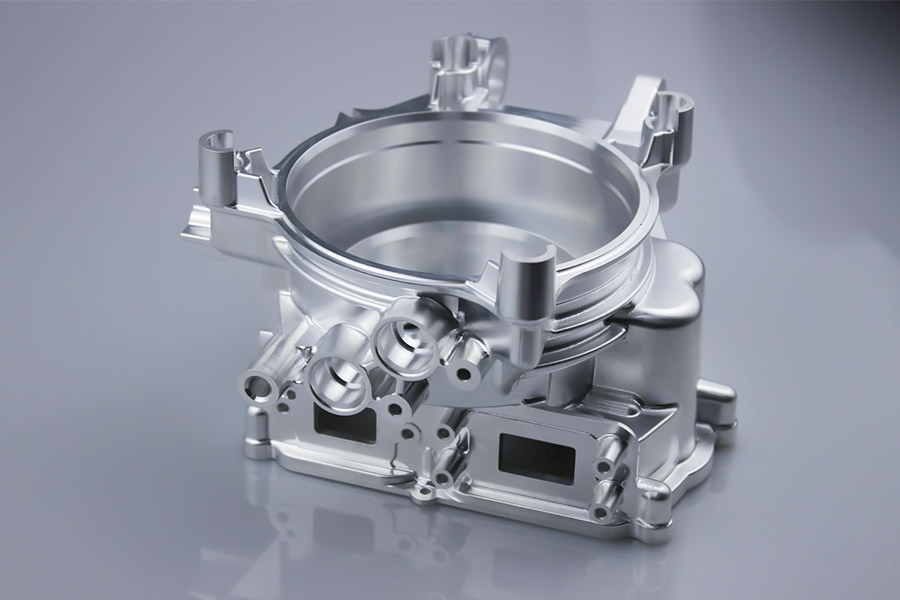
Case Study: A Complex Part Impossible on a Wood Lathe
Customer Needs:We just finished an important task for a large aerospace client: manufacturing a batch of high-precision titanium alloy turbine blades for new aircraft engines. The part is one of the core modules of the engine and is extremely valuable.
Core Challenge:The main body of the blade is a high-precision rotating body (suited for turning), but its edge is tightly covered with blades having complex three-dimensional surfaces and exact aerodynamic profiles. This geometric characteristic makes it totally impossible to machine the blades by traditional turning operations, and multi-clamping milling can't guarantee every single blade's absolute position precision and concentricity regarding the center reference, and it's even more difficult to meet strict batch consistency specifications.
LS's 5-axis solution:Confronted with this difficulty, we at LS use a high-end 5-axis linkageCNC machining center. The essence of our solution is:
- Fast turning of the base:First of all, the machine tool uses its turning function to machine efficiently and quickly the high-precision circular main body contour of the blade just as a precision lathe.
- Complicated curved surfaces are generated in one step:Then, without secondary clamping, the machine tool intelligently applies its A-axis and B-axis rotation and swing capabilities to move the precision cutting tool to implement linkage milling along each blade's own, very complex 3D spatial path to accurately generate each high-requirement blade surface.
- Accuracy guarantee:The entire machining is carried out in one clamping, which essentially eliminates repeated positioning errors and ensures very high concentricity (TIR) and absolute position accuracy between all the blades and the center rotary reference.
Results and value:In the end, we produced 100 titanium alloy turbine blades that fully satisfied the demands of the design. This not only achieved complex geometric shape that could not be achieved at all by conventional machining method (such as pure turning ormulti-clamping milling), more importantly, it ensured all 100 pieces had excellent dimensional consistency and geometric accuracy. This case fully represents the unbeatable core value of high-end 5-axisCNC machining servicesin the manufacturing of very complex and high-value-added parts in the aerospace field - high efficiency to achieve high-precision, high-complexity and high-consistency integrated manufacturing.
FAQs
1. What is the cost of 5-axis CNC machining?
The price of 5-axis CNC machining depends mainly on material, part complexity and quantity. With ouronline 5-axis CNC machiningservice platform, you can just upload yourCAD modeland get an instant quote in a matter of minutes. Our service is very competitively priced with efficient machining technology and workflow optimization to provide cost-effectiveness without any compromise on precision and quality. Please feel free to use the platform to get a customized quote instantly, which will help you plan your project schedule and budget accurately.
2. Can a metal lathe be used to process wood?
Yes, but it is not recommended.Metal latheshave slower speeds and chip handling methods that may produce unsatisfactory wood processing results, premature tool failure or even pose safety hazards. Professional woodwork lathes are designed to better accommodate the nature of wood, i.e., faster speeds and dedicated tools, and provide a better surface finish and productivity. Therefore, we recommend the use of professional equipment for the task to ensure safety and maximum results and reduce unnecessary risks.
3. Can you machine wood?
Our expertise is in machining metal and engineering plastics, which can take full advantage of the high strength and precisionadvantages of 5-axis CNC,e.g., machining complex geometries and challenging materials. Wood machining is not our usual business, as wood requires different speeds, tools and chip management, and is best machined on specialized wood working equipment. We would recommend utilizing a professional supplier for the highest quality results and to render your project efficient and reliable.
Summary
Understanding the parts of a wood lathe is a great beginning, but understanding its limitations and when to harness the power of a stronger machine is the path to becoming a master creator.
Ready to take your designs from the woodshop to the precision manufacturing floor? Upload yourCAD filenow and test our premier online platform with an instant5-axis CNC machining quote. Let's turn your complex ideas into solid reality!
📞Tel: +86 185 6675 9667
📧Email: info@longshengmfg.com
🌐Website:https://lsrpf.com/
Disclaimer
The contents of this page are for informational purposes only.LS seriesThere are no representations or warranties, express or implied, as to the accuracy, completeness or validity of the information. It should not be inferred that a third-party supplier or manufacturer will provide performance parameters, geometric tolerances, specific design characteristics, material quality and type or workmanship through the LS network. It's the buyer's responsibilityRequire parts quotationIdentify specific requirements for these sections.Please contact us for more information.
LS Team
LS is an industry-leading companyFocus on custom manufacturing solutions. We have over 20 years of experience with over 5,000 customers, and we focus on high precisionCNC machining,Sheet metal manufacturing,3D printing,Injection molding,Metal stamping,and other one-stop manufacturing services.
Our factory is equipped with over 100 state-of-the-art 5-axis machining centers, ISO 9001:2015 certified. We provide fast, efficient and high-quality manufacturing solutions to customers in more than 150 countries around the world. Whether it is small volume production or large-scale customization, we can meet your needs with the fastest delivery within 24 hours. chooseLS technologyThis means selection efficiency, quality and professionalism.
To learn more, visit our website:www.lsrpf.com


